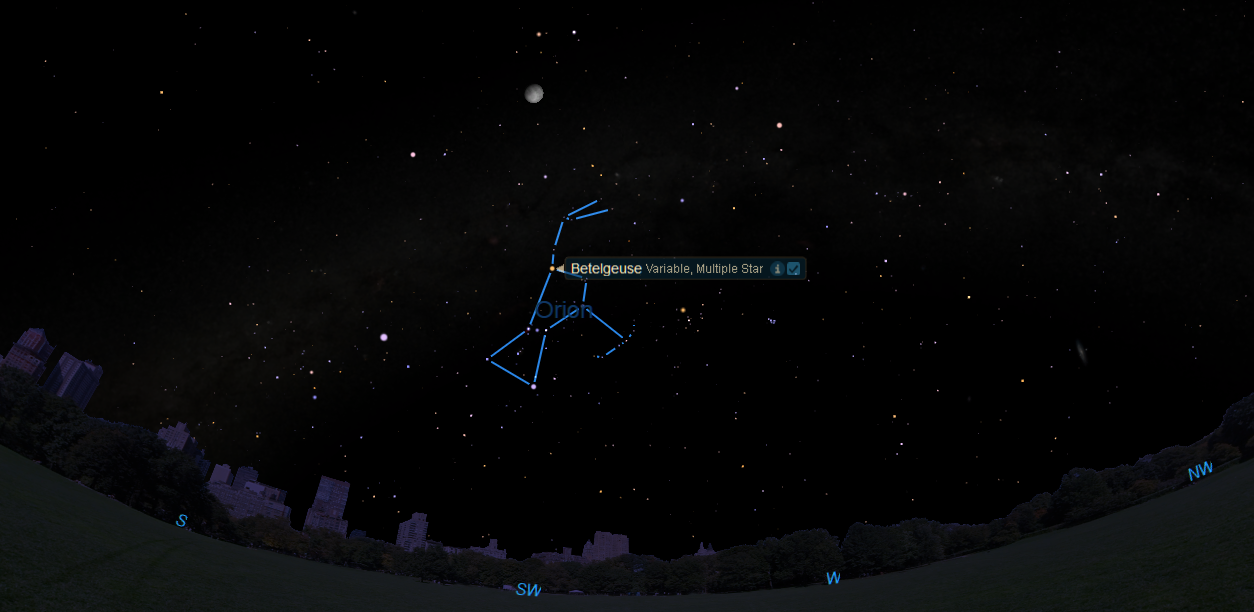The dimming star Betelgeuse is acting weird. Here's how to spot it in Orion's shoulder.

One of the brightest stars you'll see in the sky these days is Betelgeuse, whose red tones provide a fun skywatching target in February.
This monster star is about 1,000 times the size of our sun, according to NASA, and sits on the shoulder of the famous constellation Orion. The star is variable, meaning that it brightens and dims periodically. Lately, it's been dimming more, leading scientists to speculate that Betelgeuse could be somewhat close to a supernova explosion, in which the star would run out of gas to burn, then blow up.
You can easily find Betelgeuse in the constellation Orion anytime between November and February. RIght now, in New York City, Betelgeuse is rising in daylight, so you'll see it as soon as the sky darkens enough. The star is remaining above the horizon until a few hours before dawn. You can check your local times using SkySafari, a free app for Android or iPhone.
Related: The brightest planets in February's night sky: How to see them (and when)
Here's how to track down Betelgeuse: Once you go outside, give your eyes a few minutes to get adjusted to the darkness. Then turn to the southwestern sky in the Northern Hemisphere (the northwestern sky in the Southern Hemisphere) and look for the distinctive star pattern of Orion, centered on the three stars of its belt.
If you imagine Orion as its namesake, "the hunter," Betelgeuse marks the left-hand shoulder. The star is so bright and red, even in light-polluted areas, that you can't miss it. Betelgeuse is easily visible to the eye, and you won't see much more detail using binoculars or a telescope.
The star is so intriguing that the Hubble Space Telescope periodically turns its powerful gaze on Betelgeuse to see what scientists can learn. One particularly intriguing observation found a massive hotspot, the cause of which is still unknown, according to the European Space Agency.
Get the Space.com Newsletter
Breaking space news, the latest updates on rocket launches, skywatching events and more!
During its current dimming spree, you can track Betelgeuse's activity and submit your observations to the American Association of Variable Star Observers to help the group gather more information on its variability. More details on how to participate are here.
- Night sky, February 2020: What you can see this month [maps]
- Best night sky events of February 2020 (stargazing maps)
- The 10 must-see skywatching events to look for in 2020
Follow Elizabeth Howell on Twitter @howellspace. Follow us on Twitter @Spacedotcom and on Facebook.

Join our Space Forums to keep talking space on the latest missions, night sky and more! And if you have a news tip, correction or comment, let us know at: community@space.com.

Elizabeth Howell (she/her), Ph.D., was a staff writer in the spaceflight channel between 2022 and 2024 specializing in Canadian space news. She was contributing writer for Space.com for 10 years from 2012 to 2024. Elizabeth's reporting includes multiple exclusives with the White House, leading world coverage about a lost-and-found space tomato on the International Space Station, witnessing five human spaceflight launches on two continents, flying parabolic, working inside a spacesuit, and participating in a simulated Mars mission. Her latest book, "Why Am I Taller?" (ECW Press, 2022) is co-written with astronaut Dave Williams.









